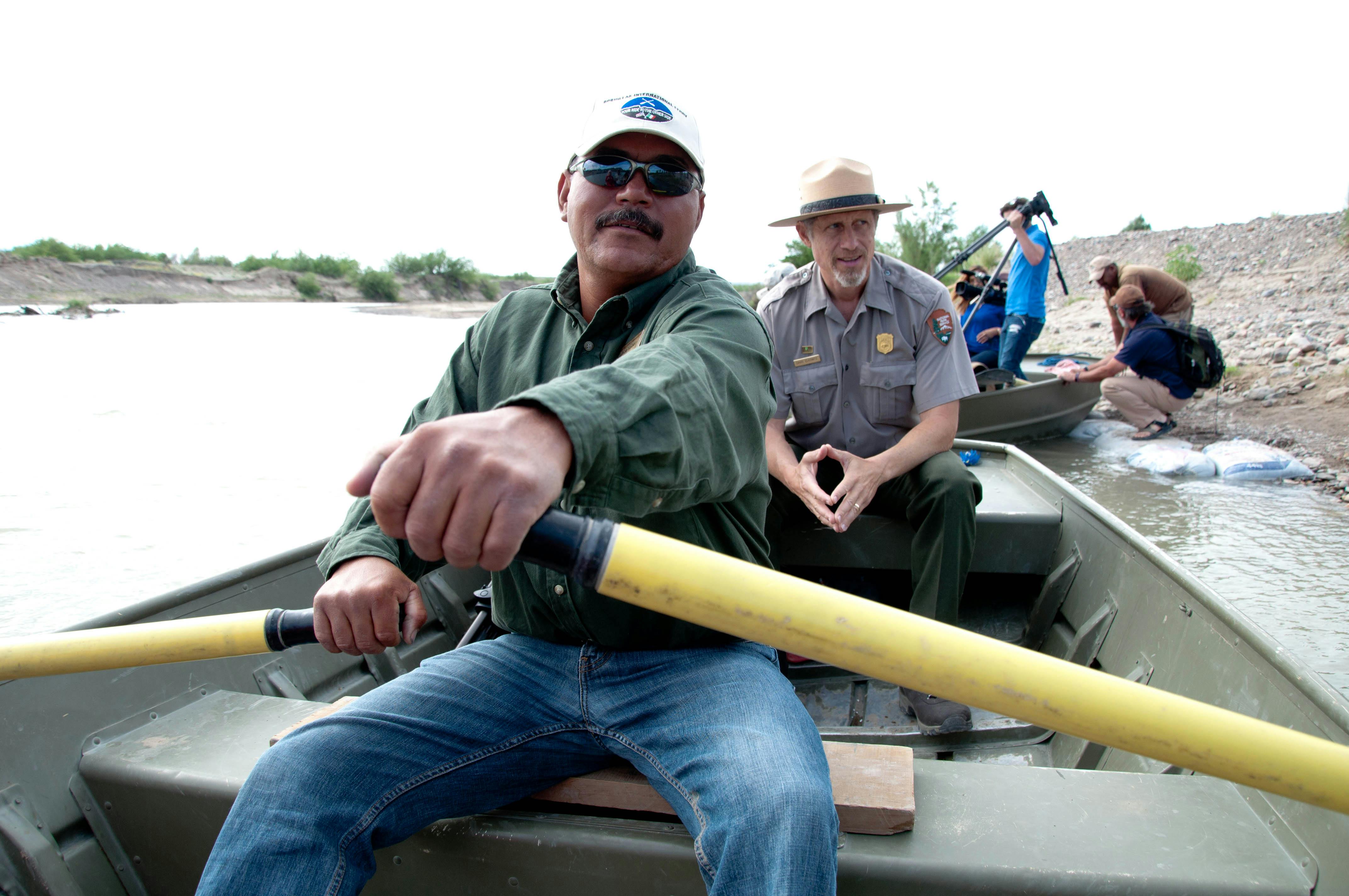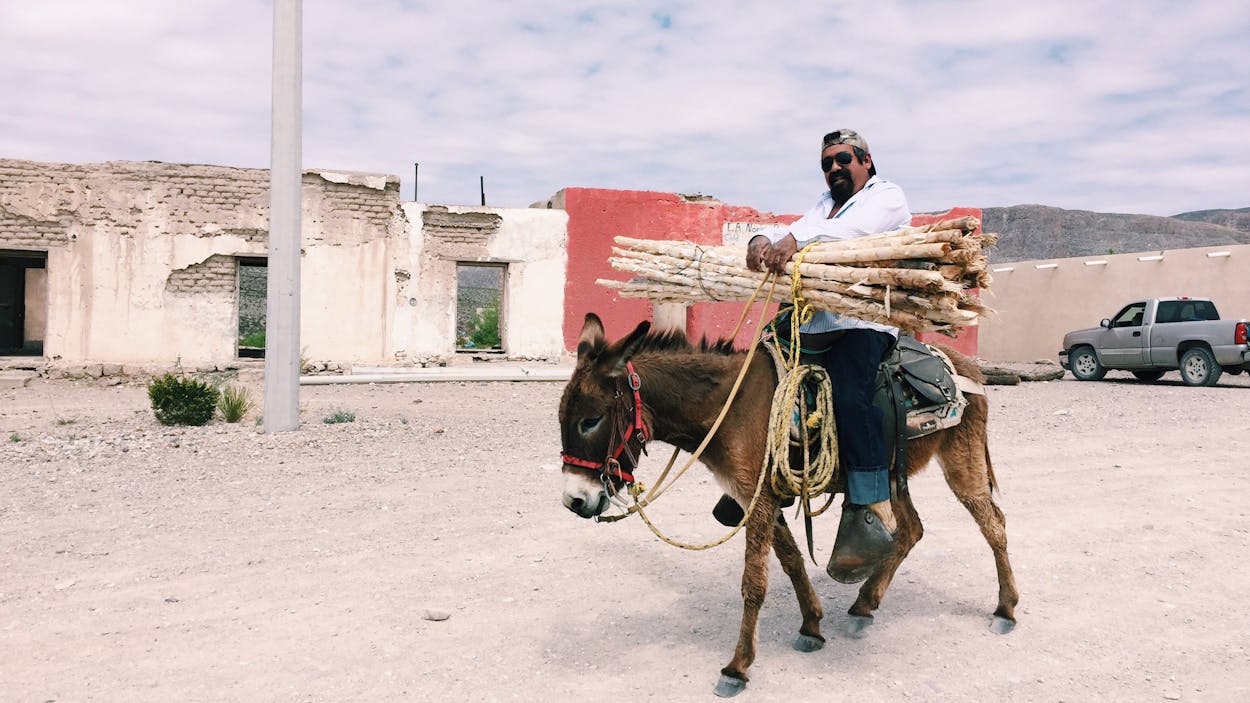Fifteen short, dark-skinned men wearing faded orange-and-white striped uniforms shuffled into the courtroom and stood in line before a judge’s bench, the words “Presidio County Jail” printed on the backs of their shirts. The thick metal chains slung around their waists jangled as they shifted uneasily.
The men, all Central American migrants pleading guilty to illegal entry into the United States, were sentenced as a group. Fourteen of them received time served, the lowest possible sentence for the crime. One man, who had a prior felony offense, received one year of probation.
Welcome to the Western District of Texas, where mass sentencings of this kind are not uncommon. The district, which comprises the Austin, Del Rio, El Paso, Midland, Pecos, San Antonio, and Waco divisions, competes for the title of the busiest federal court district in the nation with one other: the Southern District of Texas.
Heavy caseloads are consistent across the U.S.–Mexico border. The five federal judicial districts that border Mexico (California Southern, Arizona, New Mexico, Texas Western, and Texas Southern) out of 94 districts total, accounted for 60 percent of all federal arrests in 2012, up from 45 percent in 2006, according to the Bureau of Justice Statistics.
This surge in arrests might indicate of a border teeming with migrants illegally crossing into the U.S. On the contrary, the total number of “illegal alien apprehensions” has dropped by more than 70 percent over the past couple of decades, according to data published by the U.S. Border Patrol. And yet the number of immigration-related prosecutions has skyrocketed to nearly 40 percent of all federal prosecutions.
“Our geography is destiny,” says Richard Durbin, the U.S. Attorney for the Western District of Texas. “Our geography is such that, we’re on the Mexican border, where there are a lot of ports of entry, a lot of transit routes. We take the brunt of it.”
But this so-called geographic destiny is not manifest. The high volume of cases in district courts along the border is largely thanks to a Bush-era immigration enforcement protocol known as the “consequence delivery system.” This series of stringent border and immigration enforcement programs includes the Southwest sectors’ “Operation Streamline,” which allows up to 40 unauthorized immigrants to be charged with unlawful reentry at the same time. According to Pew Research, that program accounted for 45 percent of federal immigration-related prosecutions in those districts between 2005 and 2012.
Although the Big Bend sector of the U.S. Customs and Border Protection (CBP)—which encompasses the Pecos division of the Western District of Texas—does not formally adhere to Operation Streamline, its system is equally unyielding.
“Everybody who can be prosecuted, gets prosecuted,” says Bill Brooks, a spokesperson for the CBP. Exceptions to the rule include children and family units in which there is no male head of household. “Not all men are prosecuted,” Brooks says, adding, “Most are.”
Prior to the consequence delivery system, Border Patrol agents had more discretion at the point of apprehension, often returning first-time offenders to their home countries or detaining them and letting the civil immigration system, rather than the criminal system, handle the rest. The U.S. Attorney’s office reserved criminal prosecution for those with prior criminal records or for migrants who had repeatedly attempted to cross the border.
Now, virtually anyone who is apprehended is processed through the court system, regardless of criminal history. Between 2002 and 2008, federal magistrate judges along the southern border saw their misdemeanor caseloads more than quadruple, and criminal prosecutions of immigration-related misdemeanors increased by over 330 percent—from 12,411 cases to 53,697—in the border district courts. The result is a court system so inundated with petty immigration-related offenses that mass hearings and sentencings have become standard operating procedure.
“In Del Rio, you’ll have people lined up and there will be 80 people at a time,” says David Fannin, who serves as the Magistrate Judge for the slightly less busy Pecos division. His court, located in Alpine—an 85-mile drive from the U.S.–Mexico border—is so overburdened with illegal immigration cases that he must process them en masse.
A lot has changed in the past few decades. U.S. Attorney Durbin recalls that when he started working for the federal office 30 years ago, there were fewer than 20 attorneys in his office, which now has 145. Magistrate Judge Fannin’s Alpine-based job didn’t even exist. “In Alpine, nobody even thought of being a lawyer there,” Durbin says of the 6,000-small town that is home to Sul Ross State University, which is best known for its college rodeo program. Meanwhile, the neighboring Pecos court was staffed with only a part-time magistrate judge who shared an office with a DEA officer located above the town’s post office.
Twenty years ago, the Western District filed 1,178 criminal cases. Last year, that number had increased to 5,325—3,750 of those were immigration cases. “It’s an overwhelming experience,” said Michael Benavides, the divisional office manager in Pecos. His office, run by a courtroom deputy, two clerks, and himself, is responsible for processing all of the cases that come through. “We have these people coming in and out, like a revolving door.”
Fannin, who previously worked as a public defender, approaches the bench with a mild-mannered integrity reminiscent of Atticus Finch. “If we had three people on the docket today, I would have done each one individually, but we don’t have that luxury in this area or in a lot of the border areas,” Fannin says.
Although most magistrate judges typically see a greater ratio of civil to criminal cases, the vast majority of cases Fannin sees—88 percent in 2014—are criminal, and invariably fall into two broad categories: Fannin estimates that 75 percent of his cases deal with immigration and the remaining 25 percent are drug-related. By comparison, in the Austin division just 24 percent of the caseloads filed that same year were criminal cases.
Witnessing dockets in Fannin’s court can, at times, feel redundant and exhaustive. He takes care to repeat procedural statements several times to be sure the defendants understand him—a necessary safeguard in this assembly-line process. He also uses the names of the defendants before him, a habit he attributes more to his personal style.
“I don’t see them for very long,” he explains. “I like them to feel that their name is being spoken, that they’re being treated with dignity and respect and I’d like for them, hopefully, to feel that they’ve been treated fairly.”
Still, “fair” is a relative term on the border, where the sheer volume of cases can sometimes preclude standard due process procedure. In fact, in 2009, the U.S. Court of Appeals for the Ninth Circuit held that during en masse plea hearings in Tuscon, Arizona, judges must individually question each defendant and assure that they understand their rights before entering guilty pleas. But not so in the Fifth Circuit, home of the Western and Southern Districts of Texas.
“We’re so used to it that we don’t even feel like it’s not due process anymore,” says Liz Rogers, a former public defender for the Western District of Texas, who has worked as an attorney in West Texas for the past 30 years. Middle-aged and modern with a voice that grates like raked gravel, Rogers carries the aura of the cool aunt who slipped you a sip of scotch at family gatherings when nobody else was looking. “We’ve done it for so long because the numbers are so big.”

Everything’s bigger on the Texas border, including the CBP, which a little more than two decades ago was also nonexistent. In 2002, the Bush administration and Congress created the mega-bureaucracy known as the Department of Homeland Security and placed the U.S. Border Patrol within the CBP. Now, the CBP is the largest federal law enforcement agency under that umbrella.
The attacks on September 11, 2001 served as a catalyst for the expansion of border security, heightening fear of terrorist threats and creating an incentive to fortify the borders. “The first and best way to secure America’s homeland is to attack the enemy where he hides and plans, and we’re doing just that,” then-President George W. Bush said in a 2002 address to the nation. “We’re also taking significant steps to strengthen our homeland protections—securing cockpits, tightening our borders…”
And the initial surge of support for the CPB has continued. From the time the agency was formed until 2015, the federal government has increased its funding of the Border Patrol by more than 230 percent, and the number of agents has more than doubled. In 1995, the Big Bend Sector, then known as the Marfa Sector, employed 133 Border Patrol agents. By 2015, that number had risen to 549.
“In the mid-nineties, there were like two DPS troopers out here in this whole area,” Judge Fannin says. “Now, if you can drive between Alpine and Marfa without hitting a DPS trooper, I’ll give you a hundred dollars.”
Indeed, the standard white-and-green Border Patrol vehicles that police the region are as common a sight in the Big Bend as the wakes of vultures that wheel overhead in search of carrion. And in the town of Presidio, which is situated opposite the Mexican city of Ojinaga, the prevalence of the CBP’s Border Patrol agents and Customs Officers—“la migra” to those who live there—can sometimes make it feel like a militarized state.
“I think you can take it too far. Personally, I don’t know if they took it too far yet,” Fannin says. “I don’t want the area that I live in to become a police state. And it’s not yet, but, you know…” he trails off. “There was a longstanding history of people living in Mexico, then working on ranches here. It was a very porous border but it was an understood border. But 9/11 changed the world and the policymakers wanted to make sure that there are more Border Patrol people, there are more Customs people, there are more law enforcement people out here.”
But terrorist-related apprehensions at the southern border are a rare occurrence. Senior Border Patrol agent Stephen Crump, who has worked in the Big Bend Sector for the past sixteen years, could recall one terror-related incident when he ran his canine on a man at the Border Patrol checkpoint located south of the town of Marathon.
“The dog picked up nothing but everything else indicated there was something interesting going on,” Crump says. “The case agents at the time—it didn’t sit well with them either. I didn’t know because I didn’t speak to the gentleman, but his reason for being in Big Bend National Park, the type of things that he had or didn’t have in the truck made them suspicious.”
In reality, the majority of apprehensions made by the now-robust CBP in the Big Bend Sector are cases of illegal immigration and drug smuggling. “We have heroin and meth coming across the border in large quantities,” U.S. Attorney Durbin says. “There is the serious concern that people can use those smuggling routes who want to come into this country and commit those terrorist acts.” He adds, “We have the continuing threat of people coming to this country unlawfully. We don’t know where they’re going or what they’re doing.”
Unsurprisingly, Rogers, who has spent most of her career defending the very same people that Durbin prosecutes, reads the situation differently: “If there were no jobs, [immigrants] wouldn’t come,” she says. “They want to come over here so bad they can taste it. And yet they just shut that border down in response to 9/11, which had nothing to do with it.”

The tiny and far-flung Mexican border town of Boquillas del Carmen—its population recorded at somewhere around 200 people—unwittingly felt the aftershock of 9/11 in a way that few others would.
In May 2002, the border crossing that connected Boquillas to Big Bend National Park by a narrow strip of river was shut down along with all other unofficial crossings along the Rio Grande, a drastic and oblique overhaul enacted in response to the 2001 terrorist attacks. Boquillas’s economy relied on the tourism dollars of people who journeyed there on day trips, and it was devastated by the closure.
“It was very hard times. Just a few people stayed,” says Victor Valdez, known at the border crossing as the “singing boatman,” though these days he seldom boats, instead serenading people ferrying across the river from his seat at the ticket booth on the Mexican side of the border. “Other people tried to go find a better life. I never left Boquillas because it’s our home here.”
Valdez had been working at the crossing since 1971. When it closed, he had to find another way to make a living, which he did by singing his songs and selling decorated walking sticks to tourists around Boquillas Canyon, a popular hiking trail in the national park. “We had to walk from Boquillas to the canyon every day—like five miles maybe,” he says. “We don’t do that anymore because we need new knees.”
The Boquillas crossing reopened in April 2013—at that point, the population of Boquillas had been reduced to just a handful of families—and each year since the reopening the park hosts a celebration commemorating its anniversary.
Last year, U.S. Secretary of the Interior Sally Jewell attended the celebration with other U.S. and Mexican officials, who collectively signed a U.S.–Mexico Wildfire Protection Agreement that would expand collaboration between the countries in the effort to prevent and suppress fires. Jewell and her cohorts signed the agreement in Boquillas, flanked by members of the press and Mexican police in an event of mock festivity that was wholly incongruous with the character of the town itself: a tiny, tumble-down settlement sprawled upon a sloping dirt hill, where opportunity seems to orbit around the river and the traffic that runs across it, both of which scarcely flow.
Boquillas residents watched idly beside their tables upon which they displayed their trinkets and wares—miniature roadrunners and scorpions made out of bead and wire, and handkerchiefs guilelessly embroidered with the word “Boquillas.”
On an unseasonably cool day in March, I waited for Liz Rogers just outside the U.S. headquarters of the Boquillas border crossing, where I could hear Valdez’s voice rising from the river as he sang “Cielito Lindo,” the one Spanish song that most Americans who don’t speak the language are familiar with.
As I waited, a middle-aged Mexican couple carrying suitcases and two empty red gas cans waddled up the path leading from the river. There is no gas station in Boquillas, so it’s common for people in the town to cross over into the park for supplies..
A young bearded park ranger, who doubled as a customs officer during his half-day Boquillas shift, ran a search of their belongings and led the couple to scan their documents at a digital kiosk, through which they would be connected by phone to an actual customs officer out of El Paso.
Rogers arrived and we wandered down the remarkably lush path perfumed by honeysuckle. At the river crossing, we boarded a rowboat to cross the narrow and shallow band of river that functions as the natural border between the United States and Mexico. Five strokes later, we were on the other side.
In Boquillas, we met Esteban Orales, one of Rogers’s former clients, who was deported for illegal entry into the United States in 2012. Though Orales had been charged with illegal re-entry—a felony, as opposed to the misdemeanor for a first-time offense—it was reduced to a lesser charge. This was likely because of how long ago his first offense was, Rogers told me, and for his work with Los Diablos, a firefighting crew made up of several Boquillas residents who help fight wildfires in the park and beyond. But his case was an exception.
Orales, now 62, was one of the founding members of Los Diablos, and his work with the firefighting crew afforded him another perk: a Social Security card. Orales keeps his tucked away in a leather wallet among various business cards that bear the phone numbers of his children.
“Soon, I’ll get my pension,” Orales says, holding his Social Security card as delicately as a man steadying a butterfly by its wings. “Because I worked so many years in the United States.”
But Orales won’t get his pension, though he doesn’t know it. Any person in possession of a Social Security number who has been formally deported from the United States will not be paid benefits. Furthermore, pension payments cannot be reinstated unless Orales is granted lawful admission for permanent residence. And the chance of that happening is slim-to-none.
He was caught on one of several trips he’d made from Mexico to the United States, where he had been working on a ranch in Paris, Texas, illegally. The ranch owner knowingly hired him though he was not a U.S. citizen—a situation that is common, Rogers says, though employers are seldom prosecuted.
Orales would return to the ranch on foot—a nearly five-day journey during which he would traverse the unforgiving desert scape. “I wasn’t scared,” he says. “There were no bears, nothing. La migra couldn’t see me because I would walk at night.”
Orales always traveled with a couple of others “in case something happened.” “We would get a big backpack and we’d take canned corn, tuna… and one gallon of water,” he explains. “There were windmills on the ranches we’d pass through. I would use my handkerchief to filter the water from the windmills or from a stock tank.”
Despite his own experience, Orales says a fortified border has done little to stop people from crossing illegally into the United States. “It’s a risk—nothing more,” he says. “It’s a risk that many people take because they have to. There’s very little work. And a lot of people go because they have a lot of family and they need to support them.”
And indeed, Judge Fannin says, the courts often see the same people over and over again. But after the billions of dollars poured into securing our borders and creating a legal framework robust enough to prosecute hundreds of thousands of these cases yearly, the question remains: is it an effective deterrent?
Those who represent the defense don’t seem to think so. “If you don’t have anything to eat in your home country, it is human nature that you’re going to seek out a place that will provide you an opportunity to,” says Maureen Franco, the public defender for the Western District of Texas. “It’s economics 101. If there’s a demand for cheap labor, people who don’t have any opportunity in their home country go there.”
For U.S. Attorney Durbin, that’s not the point. “That’s not necessarily the reason we prosecute people,” he says. “We prosecute people because they have committed violations of statutes enacted by Congress that reflect what our norms are. We take a civilized collective approach; we mete out the punishment according to some systematic process. If some people are deterred by it, good. If not, I’m not surprised.”
Nevertheless, Orales says he hasn’t crossed the border since he was deported. Now that the border crossing is open again he has managed to find work as a tour guide in his hometown of Boquillas. “I made $150 this week,” he says, smiling.








